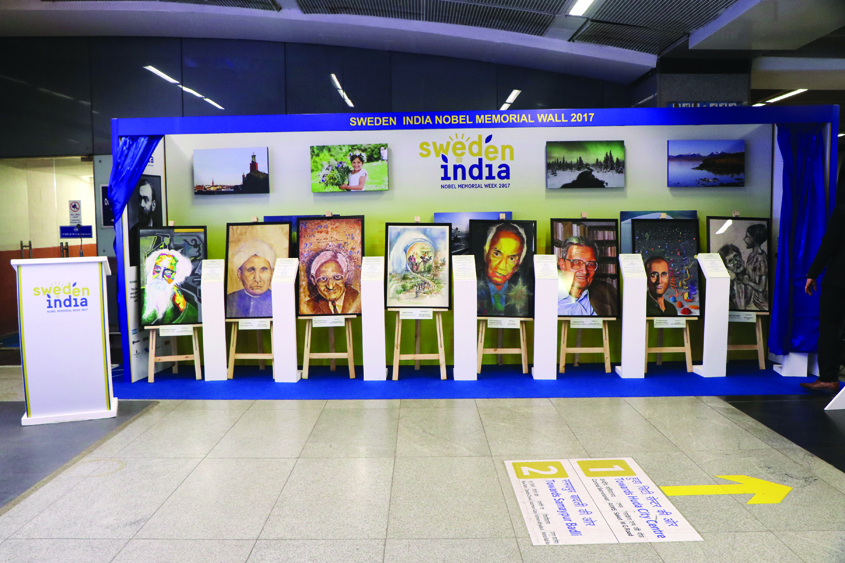The Embassy of Sweden in New Delhi, in collaboration with the Delhi Metro Rail Corporation (DMRC), inaugurated the “Sweden-India Nobel Memorial Wall” at a special event at the Rajiv Chowk Metro station on Thursday. The wall, carrying portraits of eight Indian Nobel laureates, marks the Sweden-India Memorial Week, and it was unveiled by Anna Ekström, Swedish Minister for Upper Secondary School and Adult Education and Training, and Dr Mangu Singh, Managing Director, DMRC. And the exhibit will be on display from 1-7 November at the Rajiv Chowk station.
The portraits were composed by art students from across Delhi-NCR, who were part of a larger painting competition organised by the Swedish Embassy in Delhi. Only the winning entries have been exhibited here.
“It is indeed a great pleasure to be back in India,” said Anna Ekström. “My most recent visit was in January this year and this visit also had a Nobel theme, and actually I had the opportunity to inaugurate the Nobel exhibition in Ahemdabad and one of the Nobel Laureates present there was [Venkatraman] Ramakrishnan, who is on one of the paintings over there. Alfred Nobel and the Nobel Prize of course is very close to my heart and I am so happy to see how well known they are in India. Of course, the great reason for this is you have so many Indian Nobel Laureates.”
Speaking about India’s strong cultural and diplomatic ties with Sweden, Ekström elaborated, “From the first non-European Nobel Laureate Tagore as well as non-European science Laureate C.V. Raman to [Kailash] Satyarthi fighting for child rights, India is well-represented… However, the Nobel Prize is not the only thing connecting our two countries. Today, we see even stronger political and economic ties and cooperation. Last year, my Prime Minister, Mr Stefan Löfven, visited India for the ‘Make in India Week’. There he met with his Indian counterpart, Prime Minister Narendra Modi, and they signed a joint statement to further deepen the Swedish-Indian cooperation. And that was followed by a string of high-level meetings between our two countries, which culminated in the first Make in India event ever held outside of India—which was held last month in my town Stockholm…”
About the strengthening economic ties between the two countries, Ekström said, “Today, more than 170 Swedish companies are present here, directly employing 185,000 people, and indirectly employing 1.3 million Indians. Some Swedish companies are just discovering ‘Incredible India’, while others have been here for hundreds of years. I hope there will be even more Swedish companies here hundred years from now. This was indeed a fantastic event to be present at. But before leaving this podium I just want to say that I really believe there is a firm foundation for furthering Swedish-Indian collaboration within research, innovation and within trade.”
Other prominent guests at the event included Klas Molin, Ambassador Designate from Sweden to India; Sharad Sharma, Director Operations, DMRC; and H.E. Harald Sandberg, Ambassador of Sweden to India.
The Swedish embassy in Delhi curates its Nobel-themed exhibition annually here. Thursday’s event marked the seventh edition of this enterprise, which is aimed at raising awareness of the contribution Nobel laureates from India have made to their respective fields.
About the changes that have been made in the format of the exhibition this year, Anuj Dayal, Executive Director, Corporate Communications, Delhi Metro, explained, “Normally we have it [the exhibition] at two locations, but the format has been changed this year. This time, students of art colleges were roped in. They have drawn portraits of all the Nobel laureates and this is very different from the format we had earlier. So, the location is going to be Rajiv Chowk for this exhibition. It will be a week-long exhibition, and after this I will be requesting the Swedish government to retain these for perpetuity in one of our Metro stations, so that people can see these on a regular basis.”

He further added: “Rajiv Chowk was picked as the venue this year, because it is one of the most important interchange points of the Delhi Metro. More than 500,000 people transact through this station every day. So the footfall here is very high. This exhibition will be held here every year,” added Dayal.
Also speaking on the occasion, Dr Mangu Singh said, “The inauguration of the Nobel Memorial Wall at the Rajiv Chowk Metro station has become a tradition to mark the beginning of the Sweden-India Nobel Memorial Week. This is the seventh year in a row that the wall is displayed at the Rajiv Chowk station. This being an interchange station, it provides the opportunity to a large number of people who frequent this space to familiarise themselves with, and get inspired by, our Nobel laureates. I would like to thank the Swedish embassy for partnering with us in this initiative where we remember the Indian Nobel laureates for their contribution to the world.”
The jury for the painting competition comprised the editor of the India Today Group, Kaveree Bamzai; artist Naresh Kapuria; and the head of the economic section at the Swedish Embassy, Josa Kärre.
Themed as “The Jewels of India: Indian Nobel Laureate”, the contest invited numerous entries from colleges and universities across NCR, out of which eight best entries were selected. The winners were Dinesh Manral from Noida International University (who painted Rabindranath Tagore’s portrait); Kailash Kumar Sah from Noida International University (Amartya Sen); Kevin Massey from Amity University (Subramanyam Chandrasekhar); Shyamveer Singh from Noida International University (Har Gobind Khorana); Sahil Mathur from Noida International University (Venkatraman Ramakrishnan); Narendra Kumar from Jamia Milia Islamia (Mother Teresa); Kriti Chatrath from Amity University (C.V. Raman); and Akshita Saxena from NIFT (Kailash Satyarthi).
The winners were given prize money of Rs 10,000 each, which was sponsored by the Embassy of Sweden, as well as a certificate of appreciation awarded by Anna Ekström at the Delhi event.

